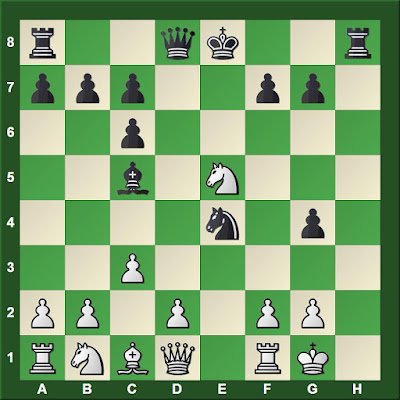Mayet,Carl - Anderssen,Adolf [C64]
London London, 1851?
1.e4 e5 2.Nf3 Nc6 3.Bb5 Bc5 4.c3 Nf6 5.Bxc6?!
This move strikes me as anti-positional. It is never played by strong masters today. Mayet -- Anderssen is the only instance of this position having been played by masters. White's idea with such a capture in other lines of the Spanish is to remove the defender. The advanced club spent some time trying to work out a refutation of 6.Nxe5 after the move played in the game. The line seems playable for both sides. Hence, while anti-positional, it does not fail tactically. However, White should be playing for an advantage and this move squanders that opportunity.
Better moves for White are 5.d3, 5.d4, or 5.0–0.
5...dxc6 6.0–0 Bg4 7.h3 h5!?
The fishing pole.
7...Bxf3 is better.
8.hxg4
8.d4 Bxf3 9.Qxf3 exd4 10.Rd1 leaves White with a slight advantage.
8...hxg4 9.Nxe5?
9.d4 Nxe4 10.g3 gives White the edge. We did not look at this position.
9...Nxe4!
This move marks the beginning of our variation, which leads to a forcing sequence at the end of which Black seems to have the edge.
9...g3? was played in the game.
White to move
10.Qxg4
10.d4 Qh4 and checkmate follows.
10...Bxf2+ 11.Rxf2 Rh1+
The critical decoy.
12.Kxh1 Nxf2+ 13.Kg1 Nxg4 14.Nxg4 Qd3
The computer prefers 14...Qh4 15.Nf2 0–0–0. I have played the Black side of this position against the computer and lost, but have won against the same engine from the position after 14...Qd3, so I prefer it.
I showed this much to the beginning students and then gave them the worksheet Beginning Tactics 2. The advanced students played out this position against Stockfish on my iPad. We made the moves on the demo board and played there.
White to move
Playing set positions from the side that has an advantage is an excellent way to train with a computer. You start with the knowledge that you have a good position and then seek to convert the advantage against resourceful defense. As often happens, errors will be punished.
White's fifteenth move is move one below.
Stockfish -- Advanced Club
28.01.2017
1.Na3 0–0–0 2.Ne3 Rh8
See below for 2...f5
3.Nac4 Qh7
The computer likes 3...Rh5. Such a move, improving the mobility of the rook, is not so easy for my students to find.
4.d4 Qh1+ 5.Kf2 Qh4+ 6.Ke2 f5 7.Nf1 g5 8.Ne5 f4
8...c5! was not considered by my students. They realize that White will soon have all four pieces in the game, so they play for checkmate. Alas, they do not see how to bring this about. What else can they do? Removing a weakness--doubled pawns--in one option.
9.dxc5 would be a blunder in the light of 9...Qe4+ forking knight and king.
9.Bd2
Black to move
9...Re8
Not certain how to proceed, the students opted to pin the knight.
10.b4
After the computer played this move, I pointed out that Black was threatening c6-c5.
10...Qh5+ 11.Kf2 g4?
11...Rf8 prepares this move.
12.Bxf4
One of the pawns lost for no reason.
12...Rf8 13.g3
Black to move
According to the engine, the position is now equal. However, White will continue to improve piece mobility, while Black's position has become difficult to play.
13...Qf5
13...a5 strikes at White's pawns. In general, when playing with a queen against a player that has none, but has other pieces of equivalent value, the player with the queen should seek to open up the position to create tactical opportunities for the queen. That is what I din in the game below, although it was only good enough for a draw.
14.Ne3 Qh5 15.N3xg4 Qf5 16.Ne3 Qh5 17.Re1 Qh2+ 18.Ng2 Qh5 19.g4 Qh3 20.Ng6 Rf6 21.Re8+ Kd7 22.Re3
Black to move
Black's position obviously has deteriorated. Perhaps during some future lesson, we will go through the previous eight moves to see where Black might improve.
22...Qxg4??
Steps into a a tactical opportunity for White.
Black remains worse after 22...Qh6 23.Ne5+ Kc8 24.Kg3 Qf8. However, this line is better than in the game.
23.Ne5+ Kd6
23...Kd8 at least does not step into a forced checkmate.
24.Nxg4+ Kd5 25.Re5+ Kc4 26.Rc5+ Kd3 27.Ne1+ Ke4 28.Nxf6+ Kxf4 29.Ng2# 1–0
After I returned home, I played another rapid game against my iPad from this position. I did not do as well as I had from the same position as a few years ago (see link below).
Stockfish -- Stripes,J
28.01.2017
1.Na3 0–0–0 2.Ne3 f5 3.Nec2 a5
3...g5 is better. When the computer thinks long enough, it finds an even better move. Black has a forced checkmate in eleven. See if you can find this sequence.
4.Ne1 Qe2 5.Nac2 Re8 6.d3 Qd1 7.Be3 Qh5 8.Nf3 g5?
I also gave away a pawn, but my plane was to exchange my rook for two minor pieces. Unfortunately, this decision substantially reduces my winning chances.
8...f4 9.Bxf4 Qb4 exchanges the f-pawn for one of White's pawns on the queenside. It also leads to a position where the mobility of Black's queen increases.
9.Bxg5 Rg8 10.Re1 Rxg5 11.Nxg5 Qxg5 12.Re8+ Kd7 13.Re2 c5 14.Ne1 b5 15.Nf3 Qc1+ 16.Kf2 Kd6 17.Ne5 Qf4+ 18.Nf3 a4 19.Re1
Black to move
19...b4 20.a3 bxc3 21.bxc3 Qg4 22.Re2 Qg7 23.Ne5 Qg8 24.Ke1 Qb3 25.Nc4+ Kd7 26.Kd2 Qa2+ 27.Kd1 Qb1+ 28.Kd2 Qa2+ 29.Kd1
29.Ke3 f4+ 30.Kf3 Qb3 and more pawns will come off the board. Maybe Black has a slight advantage.
29...Qb1+ 30.Kd2 Qa2+ ½–½
*See "Training with Anderssen" for a historical note that highlights ambiguities concerning when and where this game was played. In that link, there is also another variation played against a computer.




















No comments:
Post a Comment